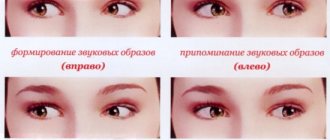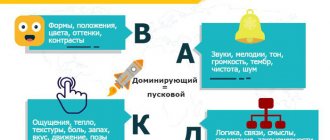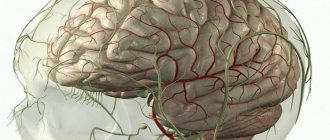Author of the material:
Inna Trofimova
writer, psychologist, gestalt therapist
What science studies types of perception and why is it needed? Is it really just to show off your erudition and knowledge of buzzwords in front of your friends? How to apply this knowledge in practice? All these questions arise every time we come across tests on the Internet to determine the type of perception. Is this a fashion statement that will soon be forgotten? No, friends, no, this trend is so fresh.
Differences between people by psychotype
I once observed a married couple at my psychological appointment. She is a well-groomed, slender, hair-to-hair blonde, with a taut back. Having aligned her legs in high heels evenly to each other, this beauty - a woman with her head held high - gracefully sat on the edge of the chair. “A very uncomfortable, but impressive-looking pose,” I thought.
And he is a heavy, squat, middle-aged man in a stretched sweater and wide jeans, unshaven, and sloppy-looking. At the same time, unlike his wife, who demonstrated an ideal appearance, he conveyed with his whole being a feeling of freedom: in an open, relaxed position, he sat on the sofa closer to the window and breathed regularly, taking in fresh air.
He enjoyed the process, his stomach rising high with each deep breath. And it seemed to me that, perceiving the monologue of his indignant wife through a phrase, he was already dozing, wrapped in a feeling of comfort.
Couple at a psychologist's appointment
“What a beauty!” my professional rejoiced inside. There are two opposing psychotypes from the category “Leading representative system in humans” - VISUAL and KINESTHETIC. And each of them is sure that their partner deliberately irritates him, causes vivid negative emotions, figuratively speaking, “makes his life unbearable.” Is this so? And how exactly do they differ?
How are types of perception determined?
There are special tests. Just out of curiosity, you can take one of these tests directly on the Internet. A lot of books have been published that talk about types of perception, among other things. As a rule, they contain simple tests that, with some degree of probability, determine which type of perception you are closer to. Psychologists work for people who have set themselves the goal of understanding their abilities and characteristics of perception. Tests for the type of perception conducted by a specialist are the most reliable and comprehensive. This leads to an absolutely logical question: “Why is this necessary?”
Take the perception type test
In order to understand the usefulness of this knowledge, it is necessary to remember the characteristics of each type of perception and work with examples. To begin with, it must be said that pure types in terms of perception are extremely rare. It's about predisposition.
Visual
These people perceive the world in most cases through their eyes. This absolutely does not mean that visual learners do not perceive sounds, smells and tactile sensations. For them, visual images carry more information and are better perceived. So, you have passed the test and determined that you are a visual person. What's next? Use this feature in self-development. Each of us learns something. The need to absorb new information arises every day.
A person who mechanically performs actions that have already been learned and brought to automaticity begins to degrade. Children study at school. How to help a little visual learner? Learn to draw pictures while mastering the material. Visual images that are associated with certain information will remain with him forever. A visual adult must follow the instructions of his superiors; your career growth directly depends on this. Draw diagrams, this is the method that will help you understand how to most effectively complete the task.
Audial
These representatives of the human race perceive information better by ear. How to use it? Kids need to read aloud. Auditory students will learn better if the majority of information is presented orally rather than through printed text. How to work as an adult auditory learner? Discuss the tasks assigned to you with your superiors and colleagues. For you, a piece of paper with instructions is less effective than direct communication. In recent years, auditory learners have been given a wonderful gift - audio books. By the way, this is another way to determine your belonging to this type. Do you prefer this way of learning? Enjoy it for your health!
Kinesthetic
These people perceive sensations, touches, and experiences more vividly. How to use this in everyday life? Perceive information emotionally and attach it to a specific feeling. You can explain your point of view to kinesthetics for a long time, giving logical arguments, but you will not achieve anything. He needs to touch, feel and pass information through emotions. This feature must be used. Are you a kinesthetic learner? Connect new knowledge with sensations that you can conjure up in your imagination.
The concept of “REPRESENTATIVE SYSTEM”
When interacting with the world around us, we receive information about it through sensory channels (representational systems) - visual, auditory, kinesthetic and discrete (logical).
A science such as NLP (neurolinguistic programming), by studying oculomotor reactions (trajectory of movement of a person’s eyeballs), analyzing speech predicates, coupled with the study of his postures and gestures, very effectively determines the leading representative system of a person.
Recommended on the topic: You don’t owe anyone anything. Except for yourself... Is this so? Components of the Self
This is the dominant sensory channel through which information about the environment enters the human brain.
What is the type of perception?
The first thoughts about the peculiarities of perception are found in the works of ancient philosophers. Around the 6th century. BC e. thinkers began to notice differences in their students' perceptions and write down their observations. These differences were interpreted in different ways, but a start had been made.
It should be noted that until the 18th century. a person was considered by scientists as a part of society, which is understandable and logical. The approach to the study of personality psychology and the development of a theory that began to allow for the principle of personal benefit in a person and the assessment of all phenomena based on their usefulness and acceptance by an individual, from the psychologists Bentham and Smith. This moment became a turning point and finally turned the views of scientists in the right direction.
In the 19th–20th centuries. The period of development of social psychology began. Researchers began conducting laboratory experiments for the first time. It was this period that gave a clear understanding of the differences in people's perceptions. Tests were created whose purpose was to determine the way a person perceives information. Now a whole science called “Socionics” is studying these subtleties.
Psychological portrait of a visual person
Often a person’s appearance is deceptive, but almost no one manages to hide their own habits and temperament. Thus, the most noticeable character traits of a visualist include:
- Tendency to order and cleanliness. The apartment or house of such a person may even surprise strangers with its cleanliness bordering on sterility; all things in the visual’s home are laid out strictly in their designated places, and the slightest disorder is instantly eliminated.
- Extremely selective memory - such an individual will fill in the smallest details of a person's clothing and face, but may completely forget about what he said. Visual learners are often advised to write down what they hear or important information; such a habit can make their life much easier (for example, when going shopping, it would be a good idea to take with you a list of necessary products and things).
- They can find fault with various little things , especially gifts. Even an expensive and sophisticated item, but carelessly packaged, will not make the proper impression on the visual eye; on the contrary, it will awaken negative emotions in him. But a simple, but decorated and tastefully presented gift will cause in him a storm of undisguised joy from the aesthetic pleasure received.
- Ease of communication. People of this psychotype are distinguished by a fairly easy-going character, and therefore communication with them will not bring the slightest discomfort to the interlocutor.
Rules for communicating with a visual person
The process of communicating with a visual person may seem quite difficult and problematic for an unprepared person. It should be understood that the overwhelming majority of visualists are not only aesthetes, but also ardent perfectionists who strive for the ideal in everything that concerns not only their own, but also other people’s appearance. But there are no people in the world who are examples of pure, absolutely standard psychotypes, and besides, we are all influenced by external factors, which greatly facilitates the communication process.
When communicating with a visual person, you can resort to some simple tricks. For example, in a conversation with a visual person, try to use phrases related to the visual perception of the world: “let’s look at it from the other side,” “your point of view is clear to me,” “I saw everything right away” - this will definitely interest him.
When choosing a gift for a visual artist, pay special attention to its packaging - it must be stylish and attractive in appearance. Remember that representatives of this psychotype, when meeting a person, largely judge him by his appearance and clothing. They also do not like long telephone conversations, and during a conversation they do not like to get too close to their interlocutor.
In addition, visual learners are extremely sensitive to the color scheme of the rooms in which they are located. Finding themselves in a room with an unpleasant color scheme, they feel awkward and uncomfortable, and their mood and performance are significantly reduced.
Professions suitable for visual people
One of the main conditions for a happy life is rightfully considered to be a favorite activity, for which a person has inclinations and abilities. Visuals are distinguished by excellent visual memory, as well as a rather specific and original manner of perceiving information; these qualities can be applied in various spheres of human life.
A visual artist can make an excellent artist, photographer, colorist, fashion designer, architect, designer, painter, costume designer and interior designer. Many visual people have a penchant for the humanities and are capable of becoming good specialists in the field of psychology and sociology; in addition, people belonging to the described psychotype make qualified and capable teachers and lecturers.
External signs of the visual
A visual person almost always operates on an external, visual image, trying to transform his oral speech into a picture. Representatives of this psychotype have excellent visual memory; in addition to it, the characteristic external signs of a visualist are:
- A speech rich in external images and numerous comparisons, in which the appearance and clothing of the interlocutor, the environment, the weather outside the window, etc. are vividly and in detail described, but other important points are often lost sight of, for example, the very essence of the conversation that took place, the result business meeting, etc.;
- When talking, the visual will try to position itself opposite the interlocutor in order to be able to constantly observe him, look him in the eyes, and at the same time examine the interiors and surroundings;
- Prefers spectacular and bright, but often not very comfortable clothes. However, visual artists carefully check each of their images , trying to fit harmoniously into the reality around them, while simultaneously emphasizing their own strengths and masking figure flaws;
- The speech of a visual person is filled with words and phrases such as “you should have seen”, “look”, “we can consider this obvious.” Such turns of speech help them better reproduce and describe the picture that has arisen in their head;
- Such individuals do not like telephone conversations , because they quickly lose the thread of the conversation without the image of the interlocutor in sight. When communicating on the Internet, a visual person will always prefer a webcam to regular text messages;
- They perfectly remember people's appearance, clothes and faces, but often cannot remember their names or other important information about a particular person;
- They do not like to come too close to the people around them, preferring to communicate at a distance of a meter or more. Thus, the visual not only does not invade someone else’s personal space, but also receives a more favorable viewing angle of the interlocutor;
- The visual gaze is not able to linger for a long time on a specific person or object; it is in constant search of new visual information;
- Having heard or read a text describing the beauties of nature or some interesting or unusual situation, the visualist will very vividly and plausibly imagine all this visually , without even wanting to;
- When equipping his own workplace, he gives preference not to comfort and functionality, but to beauty and external aesthetics . Will not refuse to sit by the window, but only if there is a beautiful view.
Visual, auditory, kinesthetic, digital in the learning process
If you study a lot, go to courses, trainings, read, then understanding your own type of perception will help you organize your own learning process with maximum benefit.
Visuals
The basis of their learning is visual information. For visual people, hearing and vision form a single whole, therefore, if such a person only heard the material (but did not see), then with a high degree of probability the information will be quickly forgotten. Visual learners instantly absorb all visual information, so it is most beneficial to use all methods and techniques for visually presenting the material:
- mind maps
- scheme
- graphs
- illustrations
- photos
- demonstration models
- experiments, experiments
Visual learners learn best through visual examples, where they see the material they are learning in real time. Primary memory is visual. They remember well the location of objects, paths, roads, and are well oriented in space. Some noise is not critical for a visual learner; he can concentrate in an environment of some noise and successfully study the material.
Visual learners perceive text information well and are able to quickly learn speed reading.
Audial
Uses the auditory perception channel as a trigger. Inner speech is moderately developed. They perceive lectures, music, conversations, and dialogues well. They clearly and effectively maintain the line of conversation and conversation; often it is during the conversation that they grasp the meaning of the material being studied. Silence is necessary when concentrating. If you are an auditory learner, then be sure to listen to lecture material and audio courses. Learn together with others, discussing the topic being studied, thinking out loud about the problem.
Kinesthetic
Receives information through actions and movements. He remembers any actions and practical exercises well. He perceives all information best through practical exercises and experiments, where he tests the information received with his own hands in practice. Information of a practical nature is especially well perceived: what moves and how, where to click.
It is important for kinaesthetic learners to feel, touch, smell, taste and fully experience the subject being studied. People of this type are very active, love and enjoy working. And they don’t like inaction. It is for kinesthetic learners that the saying “Movement is life” has a special meaning. It is very difficult for kinaesthetic people to maintain focus, they are easily distracted, it is difficult for them to sit still for a long time, or to do routine work.
Digital
They are well trained in all sciences that have strict logic and consistency: mathematics, physics, mechanics, technology. Such people often work in areas where there is a lot of research, mathematical and static processing, and programming. The main thing for digital is to understand the logic and connections in the material, to organize what is being studied into a system with clear cause-and-effect relationships. Therefore, during your studies, try to build the logic of the entire topic being studied. For this you can use:
- scheme
- mind maps
- compressed plans
- Personally compiled thesauri
Are there any disadvantages to visual learners?
Being too focused on the “cover” often plays a cruel joke on visual learners who may underestimate the “content.” A striking example is relationships with a partner. Man, although he has risen above other animals, has not lost touch with his biological nature. He is still dependent on the endless biochemical reactions occurring every second in his body. Love also relies on hormones. This is why your partner's scent is so important.
Two equally attractive girls can evoke different attractions due to differences in pheromones, which a kinesthetic person will definitely smell. And if they both open their mouths, then the auditory audience will definitely understand with whom it is better to conduct a dialogue. The discrete sums everything up logically. What about the visual? He will simply choose the most beautiful one, even if it doesn’t have the right scent or erudition. This is the great danger of being too focused on one analyzer. But pure psychotypes are not common, so visualists can simultaneously, albeit to a lesser extent, assess the situation with the help of other senses and even logic.










